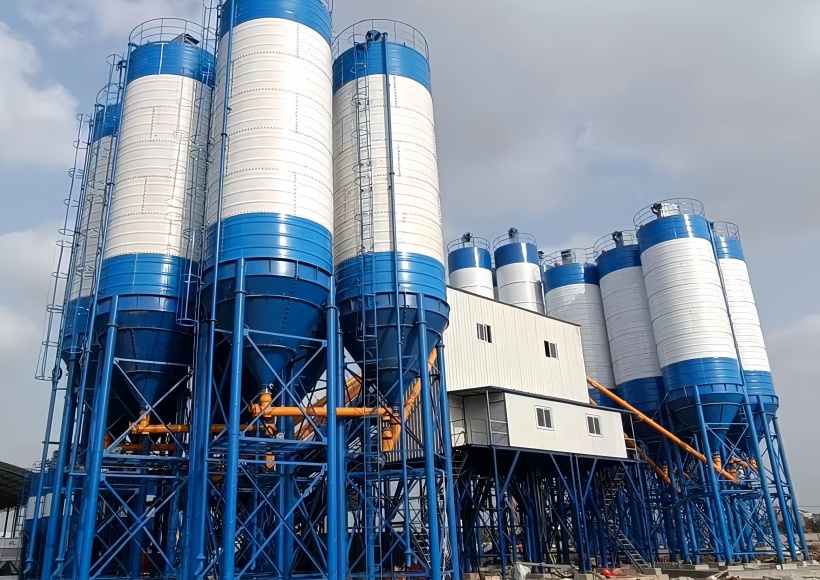With the increasing demands for environmental protection, intelligence, and efficient production in the construction industry, the standardized configuration of modern kankare batching shuke-shuke has become particularly important. This scheme, based on the latest industry standards and technological trends, elaborates on the standardized configuration requirements for modern concrete batching plants from five aspects: environmental facilities, intelligent control, kayan aiki functionality, plant layout, and operation maintenance.
I. Environmental Facility Configuration Requirements for Concrete Batching Plants
1. Three-Waste Treatment System
Modern concrete batching plants must be equipped with a comprehensive three-waste treatment system to ensure effective control of pollutants generated during production.
- Dust Removal System: Pulse bag dust collectors are recommended, with a dust removal efficiency of ≥99%, effectively controlling dust emissions.
- Wastewater Treatment System: Physicochemical treatment processes, including grating, sedimentation, and filtration, should be adopted to enable water recycling.
- Waste Oil Collection System: Dedicated collection containers and separation devices should be installed for classified recycling of waste oil.
- Waste Classification Facilities: Four categories—recyclables, hazardous waste, kitchen waste, and other waste—should be clearly labeled.
2. Residual Concrete Treatment
The residual concrete treatment system is critical for environmental compliance.
- Vehicle Washing Platform: High-pressure cleaning equipment should be installed to ensure transport vehicles are thoroughly cleaned.
- Sand-Gravel Separator: Processing capacity should match the plant’s output, generally ≥20 m³/h.
- Three-Stage Sedimentation Tank: Reasonable retention time should be designed to ensure water quality compliance.
- Sludge Filter Press: Reduces sludge moisture content to ≤30% for easier disposal.

II. Intelligent Control System for Concrete Batching Plants
1. Production Management System
An intelligent production management system significantly enhances efficiency and quality control.
- Cement SiloSensors: Patch-type sensors with ±0.5% accuracy should be installed.
- Access Control for Cement Delivery: Prevents misloading of cement via APP-controlled access.
- Online Aggregate Moisture Detector: Installed at appropriate positions in aggregate bins for representative measurements.
- Additive Tank Mixer: Prevents sedimentation while avoiding bubble formation.
- Unmanned Weighbridge: Automatically uploads data to the control center.
- Automatic Gates with Monitoring: Installed at entrances/exits of gates and storage bins.
- GPS Tracking for Concrete Transport Vehicles: Ensures real-time monitoring.
- ERP Management System: Integrates raw material procurement/consumption, production volume/ratios, and vehicle/production scheduling via APP.
2. Safety Monitoring System
A comprehensive safety monitoring system is essential for safe production.
- Control Room Monitoring: Covers all critical areas with video storage ≥30 days.
- Mixer Maintenance Cover Interlock: Prevents mixer operation when the cover is open.
- Belt Conveyor Emergency Switches: ≥2 pull-wire switches to cut power during maintenance.
- Emergency Stop Buttons: Regularly tested to ensure functionality during emergencies.
III. Equipment Functional Configuration
1. Mixer System
- Maintenance Window Power Cutoff Switch: Automatically cuts off power and locks the control cabinet when opened; requires manual reset to prevent misoperation.
- Oil Temperature Alarm: Alerts when reducer malfunctions or lubricating oil needs replacement due to temperature rise.
2. Cement Silos
- Patch-Type Sensors and Display Screens: Real-time weight monitoring and data transmission to APP for raw material inventory management.
- Access Control for Cement Delivery Pipes: Prevents misloading via APP-controlled access.
3. Batching Hoppers
- Sand Moisture Detector: Installed on bin walls to adjust water usage based on moisture content.
4. Control Center
- Multi-Screen Display: Real-time monitoring of equipment and overall plant operations for comprehensive management.

IV. Plant Layout Planning
1. Functional Zoning
Reasonable functional zoning improves operational efficiency.
- Mixing Operation Area: Equipped with safety alert lines.
- Aggregate Storage Area: Binned by specification with clear labeling.
- Testing Area: Includes standard curing rooms.
- Equipment Maintenance Area: Sufficient space for repairs.
- Office and Living Areas: Located at a safe distance from production zones.
2. Safety Spacing
- Clear Zoning Markers: Separate functional areas.
- Vehicle Turning Radius: Accommodates the longest vehicles.
- Fire Access Routes: Kept clear 24/7 with no-parking signs.
V. Operation and Maintenance Requirements
1. Daily Management
- Maintenance System: Detailed records of equipment parameters and maintenance.
- Dust Collector Filter Replacement: Every ≤6 months.
- Metering Equipment Calibration: Monthly.
2. Emergency Measures
- Emergency Plans: Cover power outages, equipment failures, and environmental incidents.
- Backup Generator: Tested monthly.
- 24/7 On-Duty System: Ensures prompt Faulthandling.
Kammalawa
Tongxin Machinery's solutions are tailored to specific project circumstances. When selecting equipment, we prioritize proven and reliable equipment and prioritize operator training. Through standardized configuration and management, concrete batching plants can operate efficiently, environmentally friendly, and safely, providing a reliable supply of concrete for engineering projects. Regular upgrades and adoption of new technologies are essential to maintaining competitiveness.